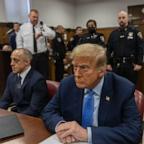Gyrocopter Was Detected by Radar Before Landing at Capitol, Pilot Deserves Stiffer Penalty, Officials Say
"The dot appeared only intermittently throughout the flight."
— -- The man who flew what he called a “flying bicycle” through restricted airspace above the nation’s capital and landed near the U.S. Capitol two weeks ago was picked up by government radars, but those radars weren't able to distinguish the small aircraft from birds or even pockets of weather, so no alarms were sounded, U.S. officials told lawmakers today.
In a separate hearing before lawmakers, Homeland Security Secretary Jeh Johnson called for tougher penalties in such cases, saying the four years behind bars that gyrocopter pilot Doug Hughes, 61, of Ruskin, Florida, is now facing isn't enough.
Johnson said Hughes' stunt "constitutes a threat to public safety, not just to the intruder but to those on the ground.”
After all, as FAA Administrator Michael Huerta acknowledged in written testimony submitted to the House Oversight and Government Reform Committee, federal officials didn't even realize that Hughes had breached restricted airspace.
"On April 15, Mr. Hughes’ gyrocopter appeared on our radar as one of those small, unidentified elements," Huerta said. "All available information about the slow moving, irregular symbol made it indistinguishable from other non-aircraft radar tracks."
In his testimony before the Senate Homeland Security and Governmental Affairs Committee, DHS chief Johnson said tougher penalties for such breaches would act "as a deterrent," and "we should consider enhancing the penalties for those types of offenses."
Hughes is charged in federal court with one count of knowingly operating an aircraft not properly registered and one count of violating national air defense space. In addition to a total of four years behind bars, Hughes faces substantial fines for his act of civil disobedience, which he hoped would bring attention to the issue of campaign finance reform.
“To me that [penalty] is completely inadequate based on the extent that Mr. Hughes put other lives in jeopardy,” said the chairman of the Senate committee, Sen. Ron Johnson, R-Wis., agreeing with the DHS secretary's assessment.
Aircraft that fly around Washington, D.C., airspace are required to be equipped with a transponder. According to Huerta's testimony, “Anything that doesn’t have a transponder shows up as a symbol resembling a simple small dot on the radar screen -- and there are typically many of them across a controller’s radar screen.”
Many of those dots are filtered out of what FAA controllers see on their screens. These dots “could be things like vehicles on nearby roadways, flocks of birds, weather events, or occasional kites or balloons,” Huerta says.
An unfiltered radar feed is shared with the Department of Defense and other agencies, so those entities can apply their own filters to the data.
After the aircraft landed, the radar data was analyzed. According to Huerta: “A trained radar analyst identified a slow-moving symbol that traveled from Gettysburg [Pennsylvania] toward the Capitol, and vanished from radar at about the time Mr. Hughes landed on the West Lawn. We now believe that unidentified radar element was Mr. Hughes’ gyrocopter. The dot appeared only intermittently throughout the flight.”
Testimony from NORTHCOM/NORAD commander Adm. William Gortney corroborates the new insight into what the government’s network of sensors saw: The aircraft was detected, but it was not sifted out from clutter to distinguish it from other objects.
“Through post-event analysis, what we now understand is that the gyrocopter was detected by several of the integrated sensors as it approached and transited through the SFRA (special flight rules area). However, the aircraft’s flight parameters fell below the threshold necessary to differentiate aircraft from weather, terrain, birds and other slow-flying objects so as to ensure that the systems and those operating them focus on that which poses the greatest threat,” Adm. Gortney’s testimony states.
Gortney acknowledges that, “Identifying low-altitude and slow-speed aerial vehicles from other objects is a technical and operational challenge.”
Testimony from the U.S. Capitol Police, U.S. Park Police, U.S. Secret Service and Sergeant at Arms largely confirms what was already known publicly about the incident based on ABC News reporting and statements from the Tampa Bay Times. A Tampa Bay Times reporter called the Secret Service and the Capitol Police at around 1 p.m. on April 15 -- approximately 20 minutes before the gyrocopter landed.
The Tampa Bay Times reporter, according to testimony from U.S. Capitol Police Chief Kim Dine, called the Capitol Police and advised them that video of the flight could be seen on a live stream. At 1:07 p.m., the Capitol Police “went to the provided website but did not find the live feed noted by the individual from the Time Bay Times.”
The Capitol Police also attempted to “validate any prohibited airspace overflight information” with the National Capitol Region Coordination Center, where other government agencies like NORAD and the FAA could share information.
The aircraft landed at 1:23 p.m.
The review by authorities is ongoing and agencies are working to develop short and long-term approaches to handling the threat posed by low- and slow-flying aircraft.




